Saint Kolbe Memorial Museum, at Hongouchi Church
Father Maximilian Kolbe was born in Poland in 1894 and was a priest of the Conventual
Order of St. Francis.
He had been active in promoting the veneration of the Immaculate Virgin Mary.
He came to Japan in 1930 and began educating seminarians and publishing a monthly
magazine ” the veneration of the Immaculate Virgin Mary.”
After that, the number of Japanese people who understood God’s teachings increased,
and Hongouchi Church was established in 1931.
 |
 |
 |
After six years in Japan, he returned to Poland for health reasons.
And then, he volunteered to die in place of a man named Franciszek Gajowniczek in the
German death camp of Auschwitz, located in German-occupied Poland.
Saint Kolbe Memorial Museum was built to commemorate his canonization in 1986.
Nakamachi Church
Nakamachi Church is located near JR Nagasaki Station which was constructed
for Japanese Christians in 1986.
The church was dedicated to the 16 Saints of Nagasaki (St. Thomas and the 15 Martyrs)
in 1988, and the monument honoring them was erected in the premise.
The 16 Saints were martyred in Nagasaki from 1633 to 1637.
 |
 |
 |
The 16 martyrs became Saints in 1987, since 26 Saint.
Dominic Ibáñez de Erquicia Pérez de Lete, Spanish, 1633, Dominican Priest
Antonio Gonzalez, Spanish, 1637, Dominican Priest
Jordan Ansalone, Italian, 1634, Dominican Priest
Luke of the Holy Spirit Alonso Gorda, Spanish, 1633, Dominican Priest
Michael de Aozaraza, Spanish, 1637, Dominican Priest
Guillaume Courtet, French, 1637, Dominican Priest
Jacobo Kyushei Gorōbyōe Tomonaga de Santa María, Japanese, 1633, Dominican Priest
Thomas Rokuzayemon Nishi, Japanese, 1634, Dominican Priest
Vincent Shiwozuka, Japanese, 1637, Dominican Priest
Francis Shōyemon, Japanese, 1633
Matthew Kohioye, Japanese, 1633
Lorenzo Ruiz, Filipino, 1637
Marina of Omura, Japanese, 1634
Magdalene of Nagasaki, Japanese, 1634
Michael Kurobioye, Japanese, 1633
Lazarus of Kyoto, Japanese, 1637
Shimabara Rebellion
The site is located in Minami-arima in Minami-Shimabara-city
and the Battle field of Shimabara Rebellion which was a peasant uprising against bakufu’s
persecution of Christians under the leadership of Amakusa Shiro in 1637.
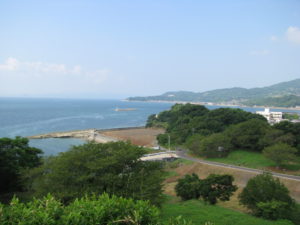 |
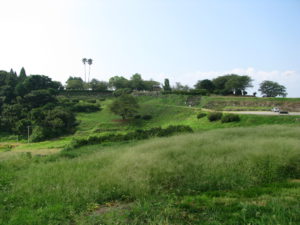 |
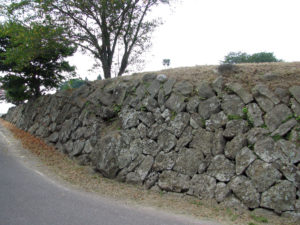 |
It was founded by Arima Takazumi in 1496 and was a flat castle with a fortress naturally created
both by the cliff facing Ariake Sea and the tide coming in. This Castle was abandoned since
Matsudaira Shigemasa, the load of Shimabara, built Shimabara Castle after the rupture of Arima
family ties.
 |
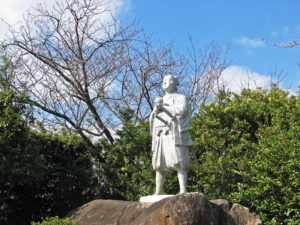 |
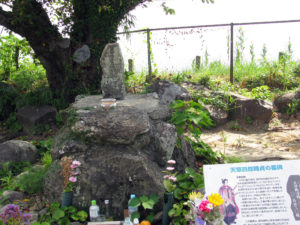 |
On February 27, 1638, he died in battle. The following day, the castle fell. 37,000 Christians
including women and children died a violent death.
It is registered on the UNESCO World Heritage as Hidden Christian Sites in the
Nagasaki Region in 2018.
26 Saints Pilgrimage route from Tokitsu to Nishizaka
26 Christians arrive at Tokitsu Port by the boat on the cold night of February 4, in 1597
and stayed one night on the boat. At dawn on February 5, they got off the ship with a cold b
ody and landed at Togitsu Port. Then they began walking the 12km path to Nishizaka,
the place of martyrdom. Passed through the mountain pass, and through Michinoo, Akasako,
and Urakami, and arrived at Nishizaka at 10 o’clock.
And as soon they arrived, they were all crucified on the cross.
 |
 |
 |
Then, Paul Miki said from the Cross
All of you who are here, please listen to me.
I did not com from the Philippines, I am a Japanese by birth, and a brother of the Society of Jesus.
I have committed no crime, and the only reason why I am put to death is that I have been
teaching the doctrine of our Lord Jesus Christ.
I am very happy to die for such cause, and see my death as great blessing from the Lord.
At this critical time, when you can rest assured that I will not try to deceive you, I want to stress
and make it unmistakably clear that man can find no way to salvation other than the Christian
way. The Christian law commands that we forgive our enemies and who have wronged us.
I must therefore say here that I forgive Taikosama (Hideyoshi).
Then they all ascended to heaven with the happy of giving the life to Christ.
In 1862, 26 Martyrs at Nishizaka were canonized by Pope Pius IX.
In 1950, Pope Pius XII designated the Nishizaka of Martyrdom of 26 Japanese
Saints as an official Pilgrimage site for Catholics
Unzen jigoku Martyrdom, 雲仙地獄殉教
When Matsukura Shigemasa became the new federal lord of Shimabara in 1616,
many people were Christians. Initially, he acquiesced in Christianity, because
he needed people’s cooperation to build Shimabara Castle.
However, this situation was known to Tokugawa Shogunate, and he strongly
commanded Christians in Shimabara to convert.
 |
 |
 |
From 1627, Christians who did not convert were persecuted using the boiling water
of Unzen jigoku.
Many Christians were taken to this Unzen jigoku and martyred.
Unzen Church is dedicated to Father Antonio Ishida, a martyr of Unzen Hell, and
martyrdom festival is held every May.
 |
 |
 |
Unzen jigoku is a tourist spot in Unzen.
Jigoku, means Hell, is the number one attraction of Unzen with a peculiar smell of sulfur
emitted from the springs, and boiled hot water and white smoke rising from the ground
over a wide area. This is a striking reminder that Unzen Volcano is still very much alive.
Genna great Martyrdom in 1622, 元和の大殉教
25 years after the martyrdom of the 26 Saints, the blood of Christians was shed
once again at Nishizaka in Nagasaki.
 |
 |
55 Christians were martyred who were arrested at Suzuta Prison in Omura and
Kurusu Prison in Nagasaki.
These included Italian missionary Carlo Spinola and Portuguese missionary
Domingos Jorge.
Ban on Christianity in 1614
The number of Christians in Japan continued to increase, and reaching 300,000 in 1614.
Fearing the ever-increasing number of Christian rebellions, Tokugawa Shogunate finally
issued a ban on Christianity in Nagasaki in 1612, and two years later in 1614 throughout
the country in Japan.
 |
 |
 |
After that, the history of martyrdom began in various places.
・in 1617, 4 missionaries were martyred in Omura
・in 1622, Genna great martyrdom (55 Christians) at Nishizaka
・in 1622-24, Ikutsuki and Nakae-no-shima island martyrdom
・from 1627, Unzen jigoku martyrdom
・1633, Nakaura Julian martyred in Nishizaka
・in 1637, Shimabara Rebellion
・in 1644, Konishi Manjo martyrdom, Domestic priests become absent
・in 1657, Persecution of Christians in Omura
・in 1790, Persecution of Christians in Urakami
・in 1839, Persecution of Christians in Urakami
・in 1856, Persecution of Christians in Urakami
Nagasaki was a small Rome
Todos os Santos Church, the first church in Nagasaki, was built in 1569.
Federal lord Omura and the Jesuits made an agreement to make Nagasaki
a port for trade with Nanban. (Portugal and Spain) in 1570.
Nagasaki Port was opened and the first Portuguese ship arrived in 1571.
And development of the town of cape was started as Christian town in 1571
and the small Church of San Paulo was constructed at the tip of cape.
 |
 |
 |
After that following Churches were constructed.
Misericordia Headquarters Church in 1583
Santa Maria Church in 1600
Santa Clara Church in 1603
Santiago Church in 1604
San Juan Petista Church in 1605
San Antonio Church in 1606
San Pedro Church in 1607
San Francisco Church in 1611
San Agustin Church in 1612
For 45 years after the first church was built, Nagasaki developed as a Christian town,
and by 1614, most of the 25,000 people were Christians.
It was as if Nagasaki was a small Rome.
However, due to the Tokugawa Shogunate’s Ban on Christianity in 1614, most of the
church buildings were destroyed within 15 days from November 3rd.
26 Saints are the first martyrs in Japan
26 Christians arrested in Kyoto who were consisted of 20 Japanese, 4 Spaniards,
1 Mexican, and 1 Portuguese.
They were forced to walk barefoot to Nagasaki for about a month.
On February 5, 1597, all 26 Christians arrived at Nishizaka and were tied to Crosses.
 |
 |
 |
Paul Miki said from the Cross
All of you who are here, please listen to me.
I did not com from the Philippines, I am a Japanese by birth, and a brother of the Society
of Jesus.
I have committed no crime, and the only reason why I am put to death is that I have been
teaching the doctrine of our Lord Jesus Christ.
I am very happy to die for such cause, and see my death as great blessing from the Lord.
At this critical time, when you can rest assured that I will not try to deceive you, I want to stress
and make it unmistakably clear that man can find no way to salvation other than the Christian
way. The Christian law commands that we forgive our enemies and who have wronged us.
I must therefore say here that I forgive Taikosama (Hideyoshi).
I would rather have all the Japanese become Christians.
(From Luis Frois’s Martyrs Records, 1597)
Jan. 4, 2024
Causes of the Martyrdom of 26 Saints
In 1596, the Spanish ship San Felipe, heading from the Philippines to Mexico, washed
ashore on the Tosa-Urato coast due to a typhoon.
Shogun Toyotomi Hideyoshi confiscated the ship’s vast cargo.
At that time, the navigator said that Spain first send Christian missionaries to increase
the number of believers, and then eventually conquer the country.
When Toyotomi Hideyoshi heard this, he was shocked and ordered the capture of
Spanish Franciscan missionaries who were actively carrying out missionary activities
in Kyoto.
 |
 |
 |
Then, he ordered Ishida Mitsunari to execute Franciscan missionaries and Christians.
This was the beginning of the Martyrdom of 26 Saints in Nagasaki on February 5, 1597.
Dec. 31, 2023
